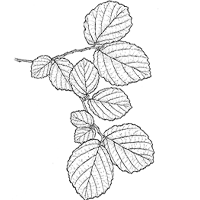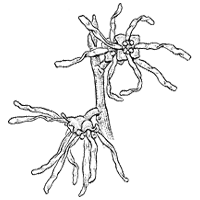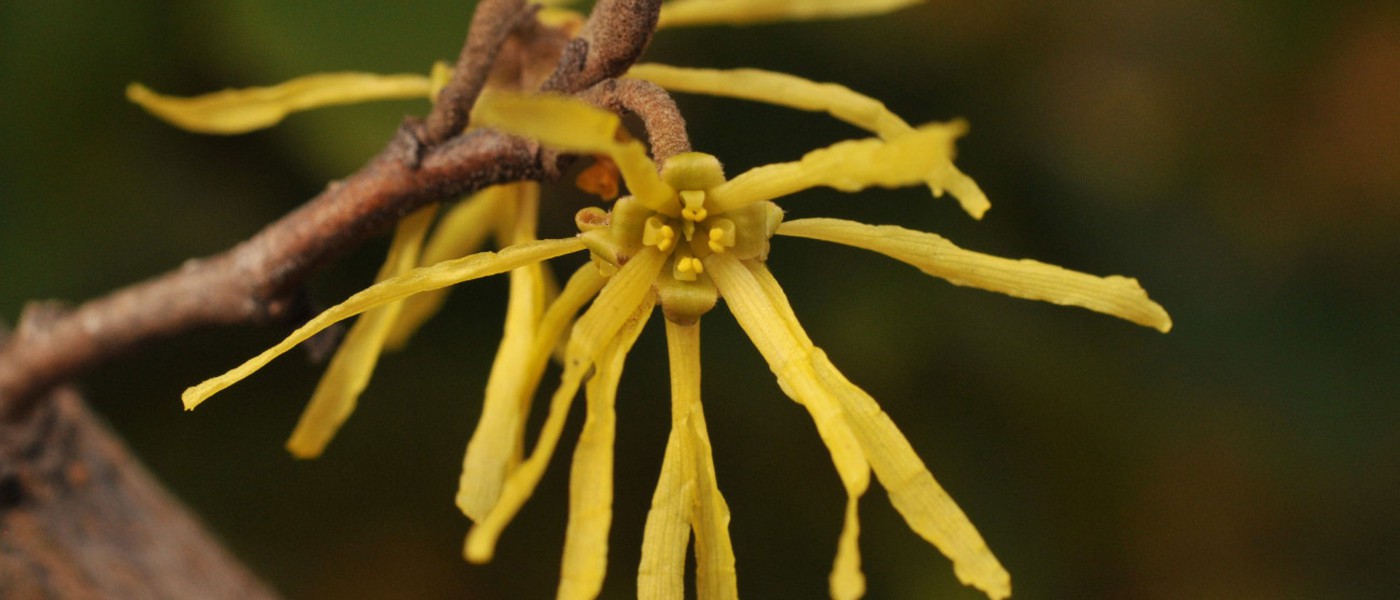Native Witch-Hazel
The American witch-hazel (Hamamelis virginiana) is one of those plants that would like to have everyone's undivided attention. You know the type: a bit of a rebel, marches to the beat of its own drum. This native shrub's unwillingness to heed convention has made it popular among gardeners for hundreds of years.

American witch-hazel has a number of traits that help it steal the limelight, including smooth gray bark, attractive architecture, and colorful fall foliage. But the real showstopper comes when you least expect it. As November approaches and most respectable plants have dropped their leaves and gone to seed, Hamamelis virginiana bursts forth in floristic splendor. Clusters of small, pale yellow blooms, each with four streamerlike petals, hug the twigs. Some flowers may linger on the branches into December.
The flowers are not as fragrant as those of the widely planted Chinese witch-hazel (Hamamelis mollis) or the popular hybrid H. × intermedia (a lovechild of H. mollis and H. japonica, the Japanese witch-hazel). But these witch-hazels all bloom in early spring. Hamamelis virginiana is the only witch-hazel that provides a dazzling late-fall display.
A Little History
Hamamelis virginiana was one of the first New World plants to be adopted for ornamental use by European horticulturists. As early as the mid-17th century, the plant was growing in private botanical collections in London. And it's been a perennial favorite ever since.
This witch-hazel has a rich history of use outside the garden setting. Traditionally, branches of H. virginiana were used as "divining rods" to locate underground sources of water. Also, extracts from the leaves, twigs, and bark were used to reduce inflammation, stop bleeding, and check secretions of the mucous membranes. But modern research has shown witch-hazel to be of questionable effectiveness as a medicine.
American witch-hazel's power to charm, however, will never diminish. Nature writer Edwin Way Teale once described it as a "botanical individualist." In his poem "Reluctance," Robert Frost laments the withering of witch-hazel's beautiful blooms with the approach of winter.
Attractive Branches and Leaves
In the wild, Hamamelis virginiana is a common shrub of North America's eastern deciduous forest, ranging from Quebec east to Minnesota and south to Florida. Common woody compatriots include pines, oaks, hickories, maples, and blueberries. Where the forest is mature and undisturbed, witch-hazel can dominate the understory and is an easy plant to get to know during a casual walk in the woods.
Slow growing and multistemmed, this witch-hazel typically reaches heights of 15 to 20 feet, but in the southern Appalachians it has been documented at 30 feet tall. The shrub has a full, rounded crown and a graceful vase-shaped habit. Its bark—thin, smooth, and gray—is quite attractive and adds interest to the winter garden. In the shade of canopy trees, witch-hazel exhibits zigzag branching and may look as though it were roaming for light, which it is. In full sun, it has more compact growth but also shows signs of stress from the direct light. American witch-hazel's branching pattern and its leaves—which are held perpendicular to the sun—make it a good competitor for the limited light found in the understory.
The leaves themselves are decorative. Broadly oval with scalloped edges and inverted-V-shaped veining, they grow up to six inches long and mature from deep green to a rich golden color in fall. Scientists have speculated that the leaves are a food source for larvae of an endangered moth, Acronicta hamamelis. One definite leaf eater is the witch-hazel leaf gall aphid (Hormaphis hamamelidis). To house its eggs, this aphid chews through the leaf underside and secretes chemicals that lead to the formation of pyramidal galls. I like to think that these witch's-hat-like galls are what inspired the plant's common name, but the literature says otherwise. The "witch" is derived from wych, an Old English word referring to the plant's pliant branches (also the root word for "wicker"). "Hazel" comes from the perceived resemblance of witch-hazel leaves to those of Corylus (hazel) species.
Flower Power
Each individual witch-hazel blossom is functionally monoecious, meaning that it's equipped with both sets of reproductive organs but acts as either a male (producing pollen only) or female (producing fruit only). Thus, any chance of self-fertilization is eliminated. Instead, the flowers use their showy petals and faint fragrance to attract pollinators to facilitate cross-fertilization. Small gnats and bees are the main pollinators, and they are rewarded for their labors with sugary nectar and sticky pollen.

Researchers suspect that the plant's unusually late flowering period induces insects to pay extra special attention to the unique blossoms—after all, the flowers are the only game in town. Indeed, it has been postulated that Hamamelis virginiana evolved a fall-flowering schedule to avoid competition for pollinators with North America's only other native witch-hazel, the spring-blooming Hamamelis vernalis (see sidebar "Our Other Native Witch-Hazel").
After pollination, actual fertilization of the seed is delayed until spring. The fruit develops during the regular growing season and is newly ripened as flowers begin to open in late autumn. Despite the fact that witch-hazel's primary means of reproduction is through seed, fruit set is extremely low, less than one percent. The fruits develop into hard, fuzzy, tan-colored capsules under an inch long, each carrying one or two dark, shiny seeds. In fall, the capsules burst and eject their seeds up to 25 feet away, but they persist on the branches for a while, resembling baby birds, beaks agape, as if expecting a worm. If left undisturbed on the forest floor, the seeds will germinate two years after dispersal. In the interim, they might be eaten by songbirds or small mammals, or even the occasional bear.
Our Other Native Witch-Hazel
The spring witch-hazel (Hamamelis vernalis) grows wild on gravel bars and rocky stream banks in the Ozark Plateau of Missouri, Oklahoma, and Arkansas. It shares its range with the more widespread H. virginiana, and some natural hybridization can occur between the two. The shrub usually grows about six to ten feet tall. In autumn, its smaller leaves turn the same illuminated golden hue as those of its cousin.
True to its name, the plant blooms in early spring. Its fragrant reddish-orange flowers appear on naked branches and add a welcome dose of color to the landscape. The flowers unfurl on relatively warm days but remain closed when it's cold to avoid damage from frost.
Unlike the lone wolf H. virginiana, spring witch-hazel has several cultivars to its name, though they are rarely found at nurseries. One is 'Autumn Embers', which sports excellent reddish-purple fall foliage. Another is 'Sandra', which has bright orange-red fall foliage.
Witch-Hazel in the Garden
The ideal garden setting for both our native Hamamelis species is in part sun to light shade and moist, slightly acidic, organically rich soils. While the best flowering occurs in full sun, planting witch-hazel out in the open will subject it to scorching and burning. As a landscaping element, individual plants are showy enough to stand on their own, but witch-hazel also works well when multiple specimens are planted together.
Balled-and-burlapped or container-grown specimens can be transplanted in spring or fall. It is recommended that you purchase your plants, since witch-hazels are difficult to propagate from cuttings and seed. Once established, American witch-hazel requires minimal care. A heavy pruning once every ten years is adequate to maintain the shrub's attractive vase-shaped habit. All pruning should be done in early spring.
Amazingly, despite the fact that Hamamelis virginiana has been in cultivation for centuries, no cultivars currently exist. More evidence of the species' individualist leanings, perhaps? Or maybe it's just simple recognition by the gardening world that this native plant—like many others, in my opinion—is perfect the way it is.
Nursery Sources:
Heartwood Nursery, Inc.2121 Blue Mount Road
Monkton, MD 21111
410-343-0390
www.heartwoodnurseryinc.com Shooting Star Nursery
160 Soards Road
Georgetown, KY 40324-9425
502-867-7979
www.shootingstarnursery.com White Oak Nursery
P.O. Box 559
Stanley, NY 14561
315-789-3509
www.whiteoaknursery.com


